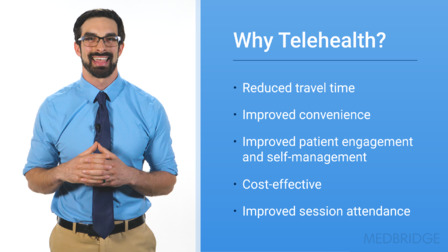-
 Virtual care delivery presents with unique organizational, practitioner, and patient benefits and barriers that do not exist within traditional in-person care. Effective use of telehealth requires the provider to recognize whether or not a patient is appropriate for telehealth, communicate the advantages and disadvantages with the patient, and understand how to resolve technical issues. The goal of this course is to address these challenges and provide clinicians with best-practice strategies to effectively incorporate telehealth into their care delivery.
Virtual care delivery presents with unique organizational, practitioner, and patient benefits and barriers that do not exist within traditional in-person care. Effective use of telehealth requires the provider to recognize whether or not a patient is appropriate for telehealth, communicate the advantages and disadvantages with the patient, and understand how to resolve technical issues. The goal of this course is to address these challenges and provide clinicians with best-practice strategies to effectively incorporate telehealth into their care delivery. -
 This course will introduce clinicians to best practices for gathering patient history during a telehealth subjective exam. Telehealth continues to be a widely used patient care model, and there are some significant differences in taking a patient's history during a telehealth visit when compared to an in-person visit. This course will go over the essentials for getting started with a subjective exam and how to improve communication remotely, structure a subjective exam in the remote environment, and determine if a patient is appropriate for telehealth.
This course will introduce clinicians to best practices for gathering patient history during a telehealth subjective exam. Telehealth continues to be a widely used patient care model, and there are some significant differences in taking a patient's history during a telehealth visit when compared to an in-person visit. This course will go over the essentials for getting started with a subjective exam and how to improve communication remotely, structure a subjective exam in the remote environment, and determine if a patient is appropriate for telehealth. -
 This course will introduce clinicians to best practices for performing a telehealth objective exam. Telehealth continues to be a widely used patient care model, and there are many differences in performing an objective exam during a telehealth visit when compared to an in-person visit. Most notably, the absence of the ability to perform manual assessments poses a challenge for obtaining accurate tests and measures remotely. This course addresses this challenge by providing alternate strategies for physical tests and measures that clinicians can apply directly to their practice in a telehealth model. This course will cover how to structure the objective exam as well as how to assess posture, movement, mobility, muscle performance, and a variety of other tests and measures during a telehealth visit.
This course will introduce clinicians to best practices for performing a telehealth objective exam. Telehealth continues to be a widely used patient care model, and there are many differences in performing an objective exam during a telehealth visit when compared to an in-person visit. Most notably, the absence of the ability to perform manual assessments poses a challenge for obtaining accurate tests and measures remotely. This course addresses this challenge by providing alternate strategies for physical tests and measures that clinicians can apply directly to their practice in a telehealth model. This course will cover how to structure the objective exam as well as how to assess posture, movement, mobility, muscle performance, and a variety of other tests and measures during a telehealth visit. -
 This course will introduce clinicians to best practices for performing Telehealth interventions. Telehealth continues to be a widely used patient care model and there are differences in providing patient interventions during a telehealth visit when compared to an in-person visit. This course addresses these differences by providing alternate strategies for interventions that clinicians can directly apply to their practice in a telehealth model. This course will cover remote interventions related to neuromuscular re-education, joint/muscle mobility, muscle performance, and patient education
This course will introduce clinicians to best practices for performing Telehealth interventions. Telehealth continues to be a widely used patient care model and there are differences in providing patient interventions during a telehealth visit when compared to an in-person visit. This course addresses these differences by providing alternate strategies for interventions that clinicians can directly apply to their practice in a telehealth model. This course will cover remote interventions related to neuromuscular re-education, joint/muscle mobility, muscle performance, and patient education
